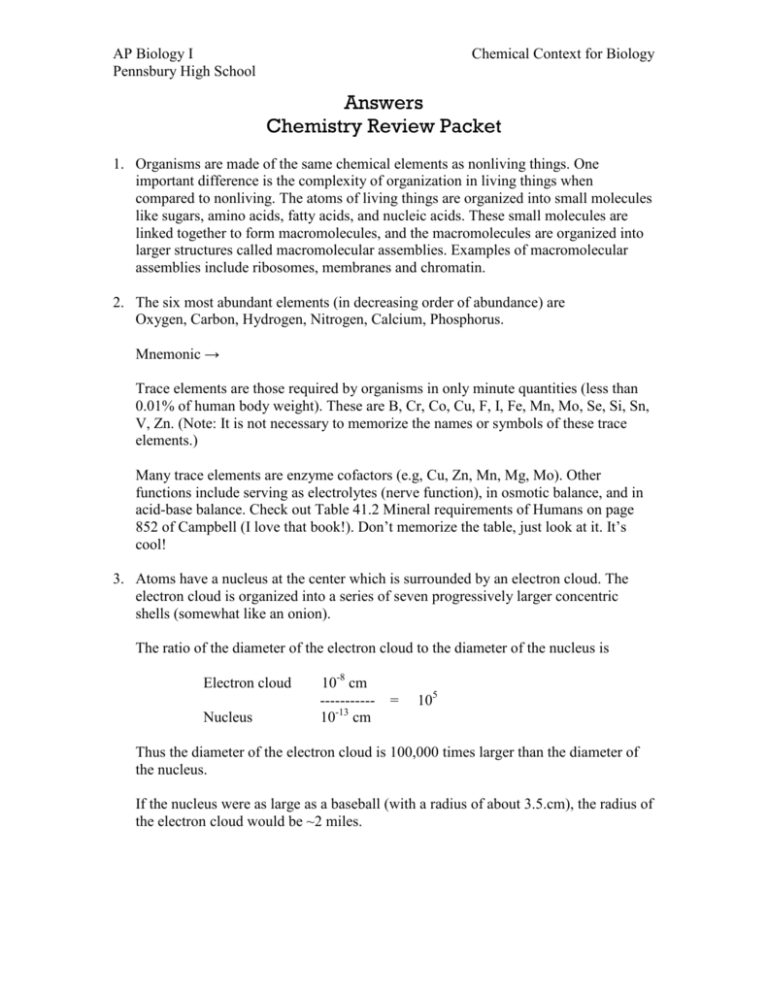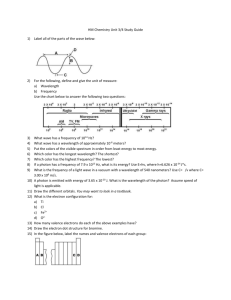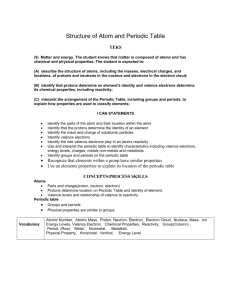Answers Chemistry Review Packet
advertisement

AP Biology I Pennsbury High School Chemical Context for Biology Answers Chemistry Review Packet 1. Organisms are made of the same chemical elements as nonliving things. One important difference is the complexity of organization in living things when compared to nonliving. The atoms of living things are organized into small molecules like sugars, amino acids, fatty acids, and nucleic acids. These small molecules are linked together to form macromolecules, and the macromolecules are organized into larger structures called macromolecular assemblies. Examples of macromolecular assemblies include ribosomes, membranes and chromatin. 2. The six most abundant elements (in decreasing order of abundance) are Oxygen, Carbon, Hydrogen, Nitrogen, Calcium, Phosphorus. Mnemonic → Trace elements are those required by organisms in only minute quantities (less than 0.01% of human body weight). These are B, Cr, Co, Cu, F, I, Fe, Mn, Mo, Se, Si, Sn, V, Zn. (Note: It is not necessary to memorize the names or symbols of these trace elements.) Many trace elements are enzyme cofactors (e.g, Cu, Zn, Mn, Mg, Mo). Other functions include serving as electrolytes (nerve function), in osmotic balance, and in acid-base balance. Check out Table 41.2 Mineral requirements of Humans on page 852 of Campbell (I love that book!). Don’t memorize the table, just look at it. It’s cool! 3. Atoms have a nucleus at the center which is surrounded by an electron cloud. The electron cloud is organized into a series of seven progressively larger concentric shells (somewhat like an onion). The ratio of the diameter of the electron cloud to the diameter of the nucleus is Electron cloud Nucleus 10-8 cm ----------10-13 cm = 105 Thus the diameter of the electron cloud is 100,000 times larger than the diameter of the nucleus. If the nucleus were as large as a baseball (with a radius of about 3.5.cm), the radius of the electron cloud would be ~2 miles. AP Biology I Pennsbury High School Chemical Context for Biology 4. Element Protons Neutrons Electrons Oxygen Carbon Hydrogen Nitrogen Phosphorus Sulfur Calcium Potassium 8 6 1 7 15 16 20 19 8 6 0 7 16 16 20 20 8 6 1 7 15 16 20 19 5 12 6 Isotope 14 N 15 N 31 P 32 P 32 S 35 S 13 C Atomic Number 7 7 15 15 16 16 6 Mass Number 14 15 31 32 32 35 14 C 6 # of Protons 7 7 15 15 16 16 C # of Neutrons 7 8 16 17 16 19 # of Electrons 7 7 15 15 16 16 6. Element Oxygen (O) Carbon (C) Hydrogen (H) Nitrogen (N) Electron Configuration 1s 2s 2p (Atoms form 2 bonds) 1s22s22p2 (Atoms form 4 bonds) 1s1 (Atoms form 1 bond) 1s22s22p3 (Atoms form 3 bonds) 2 2 4 7. Element Sulfur (S) Sodium (Na) Chlorine (Cl) Potassium (K) Neon (Ne) Electron Configuration 1s22s22p63s23p4 1s22s22p63s1 1s22s22p63s23p5 1s22s22p63s23p64s1 1s22s22p6 Valence Electrons 3s 3p4 (6 valence electrons) 3s1 (1 valence electron) 2 5 3s 3p (7 valence electrons) 4s1 (1 valence electron) 2 6 2s 2p (8 valence electrons) 2 AP Biology I Pennsbury High School Chemical Context for Biology 8. Group (Family) # of Valence Electrons Halogens (Group 17 or VIIA) Oxygen Family (Group 16 or VIA) Nitrogen Family (Group 15 or VA) Carbon Family (Group 14 or IVA) 7 6 5 4 Elements with the same number of valence electrons have similar chemical behavior. 9. Bonding 2. Bonds between O and N atoms are polar covalent. Bonds between Ca and F atoms are ionic Bonds between Li and Cl atoms are ionic Bonds between O and O atoms are nonpolar covalent 3. Na1+ and Ne have the same 2s22p6 valence shell electron configuration and both are chemically very stable. Cl1- and Ar have the same 3s23p6 valence shell electron configuration and both are chemically very stable. See review packet and pretest for answers to the rest of 3 and #4. Chapter 2 in Campbell, pp. 32-46 also reviews the chemistry that is important for the class.









